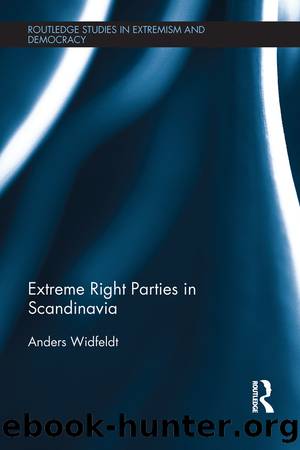Extreme Right Parties in Scandinavia by Widfeldt Anders

Author:Widfeldt, Anders.
Language: eng
Format: epub
ISBN: 9781134502141
Publisher: Taylor & Francis (CAM)
Dansk Folkeparti takes over
Pia Kjærsgaard and her collaborators formed Dansk Folkeparti on 6 October 1995, less than a week after the tumultuous FP party conference. Kjærsgaard assumed the party leadership, and was joined by three other members of parliament elected as FP representatives in 1994. This was less than half of the FP parliamentary group, but it soon became apparent that the momentum was with DF. This was confirmed in the election of March 1998, when DF received 7.4 per cent and 11 seats. Immigration was a salient issue in the 1998 election campaign, and there is much to suggest that, in its early days, DF had already driven several other parties towards a more immigration-critical position.62
After the 1998 election the place of the new party as a national political force was secured. Arguably, it had also affected the political agenda. What it was lacking was direct political influence. In a parliamentary debate on 7 October 1999 the Social Democratic Prime Minister Poul Nyrup Rasmussen stated that DF would never become legitimate. His words âyou will never be house-trainedâ have become infamous, because they would be proved wrong.63 A number of events played into DF âs hands. First, Denmark held a referendum on the introduction of the Euro in September 2000. Almost all of the parliamentary parties campaigned on the yes side; the only exceptions were the parties to the left of the Social Democrats â and Dansk Folkeparti. The vote ended in a majority against the Euro.64 This was a massive boost for the legitimacy of DF â the party could with some justification argue that it had stood with the people against the establishment. It was also a personal victory for Pia Kjærsgaard, who was branded nej-dronningen (the no queen) by the media.65
The year before the Euro vote, DF had already secured a coup by recruiting the Social Democrat Mogens Camre as a candidate in the EU election. The recruitment amounted to outright poaching â DF representatives made underhand approaches and, after initial reluctance, Camre agreed to change party. Having been a member of the Folketing between 1968 and 1987, and subsequently having worked for the Danish EU representation in Brussels, he was a major acquisition. Camre increased the partyâs potential to attract votes from the Social Democrats, and added valuable experience as well as legitimacy. He was duly elected to the EU parliament.66
Other events also worked to DF âs advantage. The most important was the terrorist attacks against the USA on 11 September 2001, which seemed to confirm the validity of DF âs criticism of Islam, and reinforced the partyâs self-image as brave and clear-sighted exponents of the âtruthâ. When Poul Nyrup Rasmussen, somewhat unexpectedly, called an election for 20 November 2001, the stage was set for Dansk Folkeparti. Immigration was the main campaign theme, not only for DF but also in general. The Liberal (Venstre) and Conservative parties promised to tighten immigration, and were joined by the Social Democrats. There were parties that did not join
Download
This site does not store any files on its server. We only index and link to content provided by other sites. Please contact the content providers to delete copyright contents if any and email us, we'll remove relevant links or contents immediately.
| Anthropology | Archaeology |
| Philosophy | Politics & Government |
| Social Sciences | Sociology |
| Women's Studies |
Cecilia; Or, Memoirs of an Heiress — Volume 1 by Fanny Burney(31332)
Cecilia; Or, Memoirs of an Heiress — Volume 3 by Fanny Burney(30934)
Cecilia; Or, Memoirs of an Heiress — Volume 2 by Fanny Burney(30889)
The Great Music City by Andrea Baker(21283)
We're Going to Need More Wine by Gabrielle Union(18072)
Bombshells: Glamour Girls of a Lifetime by Sullivan Steve(13108)
Pimp by Iceberg Slim(12931)
All the Missing Girls by Megan Miranda(12747)
Fifty Shades Freed by E L James(12451)
Norse Mythology by Gaiman Neil(11883)
Talking to Strangers by Malcolm Gladwell(11876)
Crazy Rich Asians by Kevin Kwan(8349)
Mindhunter: Inside the FBI's Elite Serial Crime Unit by John E. Douglas & Mark Olshaker(7833)
The Lost Art of Listening by Michael P. Nichols(6472)
Enlightenment Now: The Case for Reason, Science, Humanism, and Progress by Steven Pinker(6405)
Bad Blood by John Carreyrou(5768)
The Four Agreements by Don Miguel Ruiz(5510)
Weapons of Math Destruction by Cathy O'Neil(5036)
We Need to Talk by Celeste Headlee(4868)
